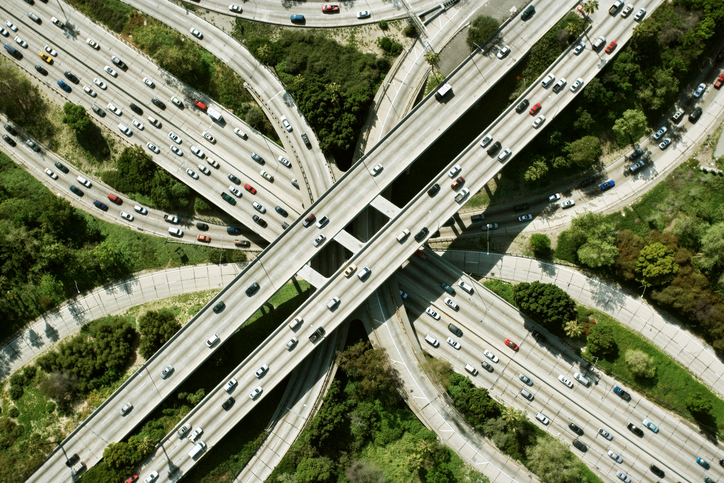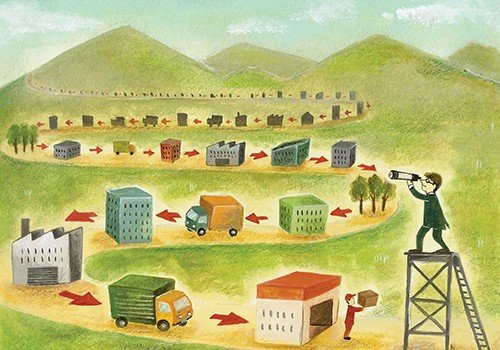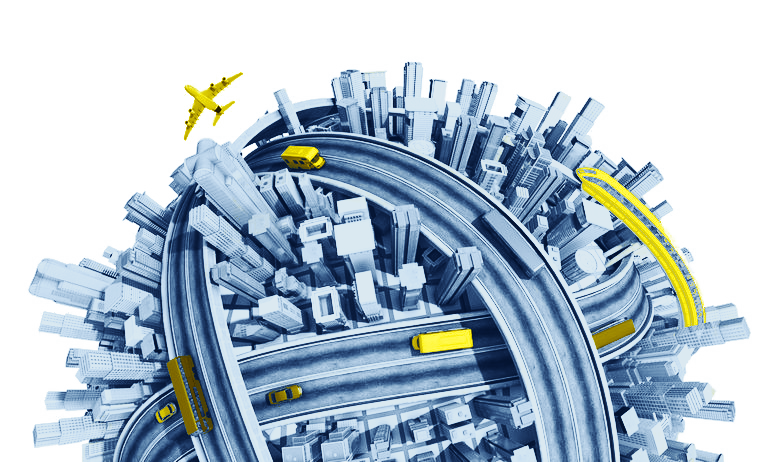A Code-Brew Labs Analysis
Foreword

Mobility is the essence of human functionality in the modern, interconnected world. Our mobility is directly represented by the global transportation industry, and the need for this industry is eternal – we cannot simply do away with it.
The transportation industry is also not a heavy, cumbersome object. It is being subjected to change by many forces whittling down on it. These can be societal, environmental and technological in their origin, but change is known to be inevitable. This industry is no exception to change.
The most common solution to increasing mobility is laying down roads, rails and other infrastructure to link geographical locations. However, can we simply pour money and time into laying down concrete structures, or are we going to evolve and find other solutions? Solutions, which are not additive, but utilise the available resources in the most efficient manner possible are the need of the hour. Environmental concerns are also mounting, and so are demands – what is the key to achieving that fine balance between all these problems?
In this analytical article, we at Code-Brew labs wish to present some of our insights about the transportation industry. We will provide a brief overview, outlining key challenges faced by the sector. In addition, we propose the efficient and clinical use of technology as remedies to many of these problems – given our status as a tech firm that supplies the same.
Our ultimate intention is to enlighten you, the reader, about the finer points of this industry in a comprehensive manner. We hope that this attunes you to the intricacies of the sector, while also enabling you to understand crucial points for disruption – if you wish to engineer something of note in the transportation industry, then we hope you can seek our guidance for the same.
Change As Inevitable
The transportation sector faces a lot of disruptions in both, its public and private faces. A lot of digital infrastructure is already being integrated with the smart-city models dominating the developed world, and current innovations in the Internet of Things (IoT) mesh.
The rising use of smartphones, wearable technology, Open traffic data, geolocation-based services and other innumerable innovations have facilitated massive changes in the sector. The customer possesses a lot of information as compared to before, and transparency is being greatly valued.
The assimilation of intelligent, secure, adaptable transportation networks will be the focus for the immediate future – the technological advent is here to stay, and will continue to invade. It is now up to the providers to adapt, or fall to the wayside.
Current Market Conditions
The global transportation and logistics market is valued to be anywhere from $2-$4 trillion in its scope, with the Boston Consultancy Group citing the latest figure to be $2.7 trillion. While this represents an astounding figure in terms of takeaways for competitors, the last couple of years have been taxing for the industry with respect to the numerous challenges and hurdles it has had to overcome.
The projected growth rate for this burgeoning industry is also variable, with some agencies citing it to be a 2.5% for the next few years while PWC is more optimistic about investments in transportation infrastructure, citing the increase to be at an average of 5%. Overall, we can safely state that the growth fluxes from a 3-4% bracket, which is a decently safe margin. Venture investors also put $5.7 billion into transportation businesses by 2015, more than twice the level of investment in the previous two years combined.
There are $2.4 trillion worth of societal benefits as a result of digital transformation of the industry up until 2025, with $1.5 trillion up for grabs, according to the WEF Paper on Logistics and Transport, published January 2016.

This growth is also not limited to developed sectors which seem more likely to integrate technology in their workings. Developing nations are leading the pack here with Sub-Saharan Africa facing a growth boost as high as 11%. Europe and other developed nations also see a shift from private transport to public, with infrastructure being largely favourable for the shift.
The Asia-Pacific region has been cited to remain the largest transport infrastructure market – investments to the tune of $557bn per year are flooding in, and PWC only expects that to rise and reach $900bn per year by 2025. Western Europe is the tail end of this growth, with rates posited at merely 1% by 2025.
According to the 2016 KPMG report, the industry was not too stellar for providers the last year, and the subpar growth in trade (3% worldwide, till November 2016) was cited as a major factor.
All in all, mature transport networks like the US and Canada are not expected to see much growth, but will see tremendous innovation – while developing nations lead from the front on those terms.
Mounting Challenges
Freight Movement and Decline

The worldly decline in trade after the economic crises of 2008-09 has led to a dramatic fall in freight movement across the globe. However, the boost in alternative modes of transport is expected to provide a small, but much needed buffer for those. The need to streamline these modes of transport is dire – otherwise, even this cushion may be precarious.
Increasing Mobility
The increasing mobility of people, on the other hand is creating a different sort of pressure on public and private infrastructure alike. The travel and tourism businesses are expanding at the rate of 6% per annum, which puts significant stress on extant and upcoming transport systems.
The Fall of Shipping
The shipping industry was hit the hardest, with overcapacities in every region and poor demand to meet this supply. Even the increase in fleet capacity only served to tilt the scales wrongly, and experts estimated losses of $5 billion in 2016 – this sector is in need of dire measures.
Semblances of Control
This year saw a significant outsourcing of logistical and transportation needs. Change management and control over these supply chains faced some dispute as a result, and contracts need to be more transparent so as to make business more ethical, and efficient.
Transparency

With technology slowly enabling the consumer to track everything from the vendors, to the suppliers and distributors – expectations have risen when transparency is concerned. Businesses need to integrate tech which facilitates this and adapt to this demand. Varying lead times and supply changes are now prone to ever-increasing scrutiny, so failure is less of an option.
Inventory Management

With trade having migrated internationally, inventory management overseas and indigenously has been a concern. The safe and efficient handling of said inventory, through changing boundaries and environments has become problematic.
Rising Demand: Flexibility and Ecommerce
The physical notion of trade and commerce may have been suffering, but ecommerce is on a steady rise. This has put pressure on all logistics-based companies, who have had to adhere to the online standard of doing things – product relaying, making its path visible and transparent, shipping guarantees, returns and many, many more elements need to be factored to satisfy the lucrative digital consumer.
Ignorance and Reluctance
Many players continue to stagnate when it comes to being on top of their game in the sphere of innovation – particularly technological – and deem it problematic to adapt to newer tech in order to manage these challenges. However, this is dangerous and the more outdated the systems, the harder it is going to be to adapt in the coming ages.
Environmental Concerns

Rising emissions and environmental degradation due to transport is a serious concern. Making the entire process efficient, from raw-materials supplied, to efficient routing and vehicular management are going to be key for managing this aspect. The downside to stagnation in this field will only result in more regulations, stunting potential and trade. The struggle to make things fuel-efficient yet profitable is a long one.
Our Offerings and Take
As a tech company for innovative solutions spanning all sectors, we have certain suggestions so that the sector’s environment does not take you by storm, resulting in the failure of your venture – new, existing or otherwise.
This is our vision of the path things will take due to digital integration in the transportation sector, and the areas to be focused on to facilitate the same.
The New Consumer
Our vision for the new consumer is the empowered one, and we already see the trend. No longer are consumers simply waiting in anonymous lines to be ferried, in complete fascination – nor are products being delivered in mystery boxes at vague times.
Consumers are largely informed now, with their travel timings and access being handled beforehand. Even supply-chain logistics are being laid bare for the consumer’s eye to track. This disrupts the industry significantly, with newer expectations as concerns the travel experience – largely to do with public modes of transport who will require to match up, seeing the decline in private car ownership.
The Sharing Economy
The sharing economy is largely responsible, with alternative transportation models like the one Uber provides, with a focus on ride-sharing and on-demand access. Last-mile logistics are all the rage nowadays, with powerful platforms facilitating location services into the technological mix.
The same goes for the transportation and shipping of all things on-demand in the ecommerce world, where time is the most precious commodity and technology is being used to remedy its loss wherever possible in the whole chain.
Open Data and Integration

The use of data mining, big data and analytics is driving transportation into a more efficient direction. This tech attempts to remedy many challenges, such as inventory management, advertising concerns, meeting the consumer’s needs with careful research, customer outreach programs, routing solutions and predictive measures that need to be effected for optimization.
Network monitoring and troubleshooting has become much, much more effective than before due to data being gathered from multiple sources. Integration of physical infrastructure, be it road-rail-air-water-based transport and data steams make it one cohesive, intelligent system that can truly transform it.
Integrating these services into your logistics venture may seem costly in the beginning, but the benefits far outweigh the problems.
IoT Infrastructure

The smartphone is a potential data-collection device, a location-solution, a feedback mechanism and access portal to the provider – its capabilities are slowly approaching limitlessness. This smartphone along with other tech in various vehicles becomes an IoT mesh, all transmitting and receiving vast amounts of information for transparency, and adaptive optimization. Almost 80% of manufacturers are developing mobile applications, and at a more rapid rate than traditional applications for enhanced logistical support in response to the increase in this infrastructure.
Autonomous

The Autonomous vehicle and its development is of great interest, since it promises to improve vastly upon human agency when it comes to logistics and transportation – particularly personal transport. A Deloitte report suggests that there will be as many as 22 billion sensors in cars by the end of 2020, making the car an autonomous entity capable of serving as an efficient operator. Safety and cognitive systems that integrate AI herald change already, with companies like Tesla motors in the fray.
Geo-Superiority

With the rise of the LBS industry, geosequencing, tagging and location-oriented data are becoming more and more attuned to the volatile environments that transportation-modules go through Adapting superior technology when it comes to these services will be crucial to cut through the competition.
Alternative Revenue Streams, Payment Methods
The pricing for many of these logistics based services, along with transportation have become profoundly different, as revenue models become highly competitive – in tandem, they also become adaptive since flat-line revenue models have only shown to generate losses in today’s environment with many changing variables.
The convenience and safety of payment gateways becomes paramount as they become virtual. Cashless, virtual transactions are the current mode of engagement, and gateways have also turned increasingly mobile with smartphone adoption. Finding the right technology here will benefit providers and consumers alike. The card as an all-access pass is not too far from reality worldwide.
In conclusion
As can be anticipated, it is a very exciting moment for the transportation industry. The sector will surely face tremendous disruption with every new technological innovation.
We consider it our duty to inform potential clients of the perils, and advantages to be found in every sector. We also consider it our privilege to work with those who are interested in augmenting their ideas with powerful technology. We are eager and only too happy to walk you through the possibilities of these measures, targeting key concerns in the sector itself, so that your business can bloom with minimal hitches.
All the technological solutions mentioned above – in the realm of big data, analytics, mobile app development, the engineering of virtual architecture and so on – can be found by working with us, in the most cogent manner possible. We will be honoured to help your venture disrupt the transportation vertical – all you need to do is take the first step, and open a dialogue with us.






